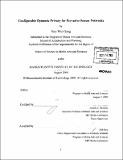| dc.contributor.advisor | Joseph A. Paradiso. | en_US |
| dc.contributor.author | Gong, Nan-Wei | en_US |
| dc.contributor.other | Massachusetts Institute of Technology. Dept. of Architecture. Program in Media Arts and Sciences. | en_US |
| dc.date.accessioned | 2010-05-25T21:02:02Z | |
| dc.date.available | 2010-05-25T21:02:02Z | |
| dc.date.copyright | 2009 | en_US |
| dc.date.issued | 2009 | en_US |
| dc.identifier.uri | http://hdl.handle.net/1721.1/55190 | |
| dc.description | Thesis (S.M.)--Massachusetts Institute of Technology, School of Architecture and Planning, Program in Media Arts and Sciences, 2009. | en_US |
| dc.description | Cataloged from PDF version of thesis. | en_US |
| dc.description | Includes bibliographical references (p. 76-79). | en_US |
| dc.description.abstract | Ubiquitous computing sensor networks have greatly augmented the functionality of interactive media systems by adding the ability to capture and store activity-related information. Analyzing the information recorded from pervasive sensor networks can provide insight about human behavior for better personalized system services, as well as richer media content and social communication. With these increased capabilities, serious concerns which create great obstacles to the deployment of such network are raised with regard to privacy and boundaries. However, there exist no real data currently about privacy in pervasive media networks and most studies that have been made so far are speculative. This thesis presents the design and implementation of a configurable infrastructure that can protect users' dynamic levels of privacy in a pervasive sensor network. Through an active badge system, users have different options to disable each type of data transmission. This work evaluates approaches for privacy protection through conducting an extensive user study in an actual ubiquitous invasive sensing environment to obtain feedback via sensor system data and questionnaires and correlates that information for future reference in the design of privacy-protected ubiquitous sensor networks. Results from the user study indicated that an active badge for on-site control, especially periodically broadcast RF beacon for privacy control, is the most effective and acceptable method. | en_US |
| dc.description.abstract | (cont.) However, it also suggested that if every occupant in the building used this approach to constantly block all data transmission, significant system blinding (on the order of 30 % or more) would be incurred. These results allow a better understanding of what value is assessed to privacy versus capabilities/awareness beyond the current assumptions. | en_US |
| dc.description.statementofresponsibility | by Nan-Wei Gong. | en_US |
| dc.format.extent | 106 p. | en_US |
| dc.language.iso | eng | en_US |
| dc.publisher | Massachusetts Institute of Technology | en_US |
| dc.rights | M.I.T. theses are protected by
copyright. They may be viewed from this source for any purpose, but
reproduction or distribution in any format is prohibited without written
permission. See provided URL for inquiries about permission. | en_US |
| dc.rights.uri | http://dspace.mit.edu/handle/1721.1/7582 | en_US |
| dc.subject | Architecture. Program in Media Arts and Sciences. | en_US |
| dc.title | Configurable dynamic privacy for pervasive sensor networks | en_US |
| dc.type | Thesis | en_US |
| dc.description.degree | S.M. | en_US |
| dc.contributor.department | Program in Media Arts and Sciences (Massachusetts Institute of Technology) | |
| dc.identifier.oclc | 609402379 | en_US |
